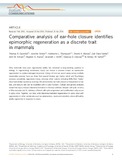Comparative analysis of ear-hole closure identifies epimorphic regeneration as a discrete trait in mammals

View/
Date
2016Author
Gawriluk, Thomas R
Simkin, Jennifer
Thompson, Catherine L
Biswas, Shishir K
Zak Claire-Salzler
Kimani, John M
Kiama, Stephen G
Smith, Jeremiah J
Ezenwa, Venessa O
Steifert, Ashley W
Type
ArticleLanguage
enMetadata
Show full item recordAbstract
Why mammals have poor regenerative ability has remained a long-standing question in
biology. In regenerating vertebrates, injury can induce a process known as epimorphic
regeneration to replace damaged structures. Using a 4-mm ear punch assay across multiple
mammalian species, here we show that several
Acomys spp
. (spiny mice) and
Oryctolagus
cuniculus
completely regenerate tissue, whereas other rodents including MRL/MpJ ‘healer’
mice heal similar injuries by scarring. We demonstrate ear-hole closure is independent of ear
size, and closure rate can be modelled with a cubic function. Cellular and genetic analyses
reveal that injury induces blastema formation in
Acomys cahirinus
. Despite cell cycle re-entry
in
Mus musculus
and
A. cahirinus
, efficient cell cycle progression and proliferation only occurs
in spiny mice. Together, our data unite blastema-mediated regeneration in spiny mice with
regeneration in other vertebrates such as salamanders, newts and zebrafish, where all healthy
adults regenerate in response to injury.
Rights
Attribution-NonCommercial-NoDerivs 3.0 United StatesUsage Rights
http://creativecommons.org/licenses/by-nc-nd/3.0/us/Collections
The following license files are associated with this item:

